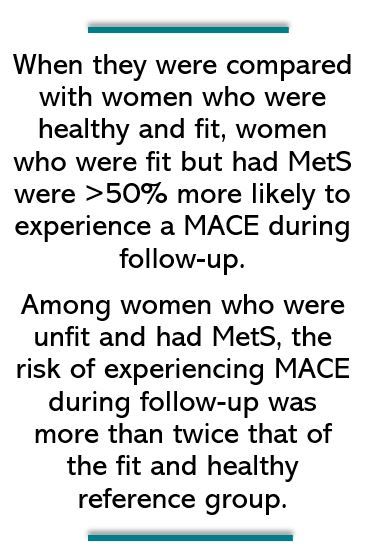Metabolic Syndrome and Poor Fitness in Women Increase Long-term CVD Risk: New Research
Women with ischemic heart disease who have metabolic syndrome (MetS) but who are physically fit and those without MetS but who are physically unfit are at increased risk for long-term, major adverse cardiovascular events (MACE) and mortality, according to new findings.
©Dusan Kostic/Adobe Stock

The cautionary results come from an analysis published April 23, 2023, in the American Journal of Preventive Cardiology of nearly 500 women enrolled in the Women's Ischemia Syndrome Evaluation (WISE) cohort undergoing invasive coronary angiography. Investigators say the findings support screening women for activity levels.
In adults with metabolic risk factors, higher levels of fitness have been associated with lower risk of poor CVD outcomes and mortality, wrote authors led by C Noel Bairey Merz, MD, professor of medicine and director, Barbra Streisand Women’s Heart Center at the Smidt Heart Institute, Cedars-Sinai. But research to date, they added, has been limited to cohorts without known CVD history, cohorts predominately comprised of men, or to study of a single metabolic risk factor.
“Fitness is also associated with lower risk of developing diabetes and in women with diabetes, fitness has been associated with lower risk of CVD outcomes and mortality,” added the authors. “The association of fitness and the cluster of metabolic risk factors that make up the metabolic syndrome on longer-term major adverse CV events and mortality in women with CVD remains unknown.”
Merz and colleagues analyzed data from 492 women enrolled in the prospective WISE cohort (1997-2001) who underwent invasive coronary angiography and had symptoms of ischemic heart disease.
The team investigated the association of fitness, as well as MetS and dysmetabolism (includes treated type 2 diabetes), with long-term CV outcomes and risk of all-cause mortality during a median 8.6 years of follow-up. Fitness was measured by self-reported Duke Activity Status Index (DASI), with fitness defined as >7 metabolic equivalents of task (METs). MetS and dysmetabolism were defined according to ATP III criteria.
FINDINGS
Merz and colleagues report that at baseline, 34% of participants had obstructive coronary artery disease. Within the cohort:
- 19.5% of women were considered to be fit and metabolically healthy (reference)
- 14.4% were fit and met criteria for MetS
- 29.9% were deemed unfit but metabolically healthy
- 36.2% were deemed unfit and met criteria for MetS
Overall, the investigators found 23.6% of participants had MACE (median follow-up 5.9 years) and 15.7% of the cohort died (median follow-up 8.6 years). The highest proportion of MACE events (51.7%, P<.001) and all-cause mortality (51.9%, P=.009) were in the women who were unfit and had MetS.

When they were compared with women who were healthy and fit, women who were fit but had MetS were >50% more likely to experience a MACE during follow-up (hazard ratio [HR] 1.52; 95% CI, 1.03-2.26). Among women who were unfit and had MetS, the risk of experiencing MACE during follow-up was more than twice that of the fit and healthy reference group (HR 2.42; 95% CI, 1.3-4.48).
Compared with fit and healthy women, those who were physically fit but had dysmetabolism, which included treated T2D, were nearly twice as likely to die during follow-up (HR 1.96; 95% CI, 1.29-3.00). Among the women who were unfit with dysmetabolism, the risk of death increased threefold (HR 3.0; 95% CI, 1.66-5.43).
In a secondary analysis, Merz et al used a higher cutoff for fitness level (>10 METs) to assess the difference in women who were highly fit and found women with METs <10 who had MetS were at a 2.6-fold greater risk of mortality compared to women who were metabolically healthy and fit. “These findings suggest that in women with ischemic heart disease, higher fitness may be needed to improve mortality.”
Among study limitations, Merz and colleagues noted that because participants with poorer health are less likely to be fit, underlying disease may have introduced potential bias into the analyses; however, women with significant comorbidities were excluded from the WISE cohort and researchers adjusted for significant comorbidities in the analyses.
“The public health burden associated with metabolic syndrome and diabetes is substantial,” the researchers wrote. “This study highlights the importance of fitness assessments, easily obtained by a patient-reported measure, in risk stratification.” The findings also suggest that the role of metabolic health and fitness in CV outcomes warrants further investigation.
Reference: Quesada O, Lauzon M, Buttle R, et al. Fitness attenuates long-term cardiovascular outcomes in women with ischemic heart disease and metabolic syndrome. Am J Prev Cardiol. Published online April 23, 2023. doi:10.1016/j.ajpc.2023.100498